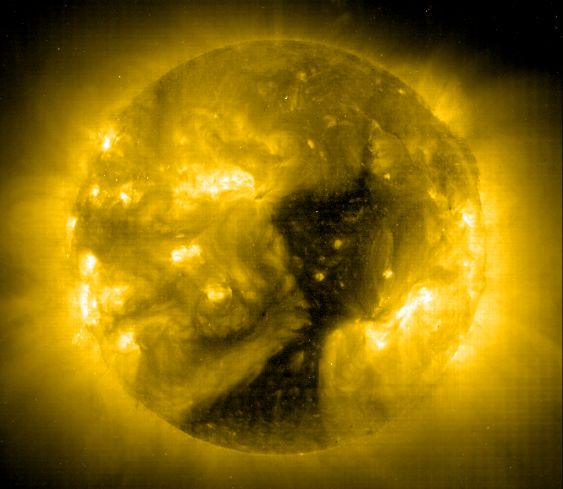
|
Explanation: This ominous, dark shape sprawling across the face of the active Sun is a coronal hole -- a low density region extending above the surface where the solar magnetic field opens freely into interplanetary space. Studied extensively from space since the 1960s in ultraviolet and x-ray light, coronal holes are known to be the source of the high-speed solar wind, atoms and electrons which flow outward along the open magnetic field lines. During periods of low activity, coronal holes typically cover regions just above the Sun's poles. But this coronal hole, one of the largest seen so far in the current solar activity cycle, extends from the south pole (bottom) well into northern hemisphere. Coronal holes like this one may last for a few solar rotations before the magnetic fields shift and change configurations. Shown in false-color, this picture of the Sun on January 8th was made in extreme ultraviolet light by the EIT instrument on board the space-based SOHO observatory.
|
January February March April May June July August September October November December |
| ||||||||||||||||||||||||||||||||||||||||||||||||
NASA Web Site Statements, Warnings, and Disclaimers
NASA Official: Jay Norris. Specific rights apply.
A service of: LHEA at NASA / GSFC
& Michigan Tech. U.
Based on Astronomy Picture
Of the Day
Publications with keywords: corona - coronal hole - Sun - solar wind
Publications with words: corona - coronal hole - Sun - solar wind
See also:
- APOD: 2025 May 21 Á International Space Station Crosses the Sun
- APOD: 2025 March 16 Á Venus and the Triply Ultraviolet Sun
- APOD: 2024 September 2 Á A Triangular Prominence Hovers Over the Sun
- APOD: 2024 August 18 Á A Solar Prominence Eruption from SDO
- APOD: 2024 August 4 Á Gaia: Here Comes the Sun
- APOD: 2024 July 28 Á Sun Dance
- Prominences and Filaments on the Active Sun
